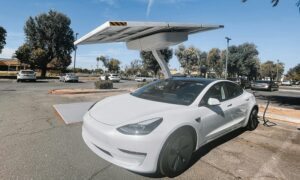Introduction to Sustainable Mobility Solutions
Sustainable mobility refers to the movement of people and goods in a way that meets current automobile needs without compromising the ability of future generations to meet their own needs. As the world becomes increasingly aware of the negative impact of traditional modes of transportation on the environment, there is a growing demand for sustainable mobility solutions.
In recent years, advanced automobile technology has played a significant role in shaping a greener future by offering innovative solutions that prioritize sustainability. These solutions aim to reduce carbon emissions, conserve energy, and promote eco-friendly practices in all aspects of transportation.
One key aspect of sustainable mobility is reducing carbon emissions from vehicles. Traditional gasoline-powered cars contribute significantly to air pollution and climate change through tailpipe emissions. In response, automakers have been developing and promoting alternative fuel vehicles such as electric cars, hybrid cars, and hydrogen fuel cell vehicles.
Electric cars are powered by rechargeable batteries instead of internal combustion engines. This not only eliminates harmful emissions but also reduces dependence on fossil fuels. Hybrid cars combine both an electric motor and an internal combustion engine, resulting in lower fuel consumption and reduced emissions. Hydrogen fuel cell vehicles use hydrogen gas as a source of power and emit only water vapor as exhaust.
Evolution of Automobile Technology: From Fossil Fuels to Electric and Hybrid Vehicles
The automobile industry has come a long way since the invention of the first gasoline-powered car in 1886 by Karl Benz. Over the years, technological advancements have revolutionized the automotive sector, making it faster, safer, and more convenient for people to travel. However, with increasing concerns about climate change and environmental degradation caused by fossil fuels, the industry has had to adapt and evolve towards more sustainable mobility solutions.
One of the biggest shifts in automobile technology has been the move away from traditional fossil fuels towards electric and hybrid vehicles. This shift is driven by the need to reduce carbon emissions and dependence on non-renewable resources.
Electric cars run solely on electricity stored in batteries and do not emit any harmful gases into the atmosphere. They are powered by an electric motor that converts electrical energy into mechanical energy to drive the wheels. The development of lithium-ion batteries has made it possible for electric cars to have longer range capabilities and faster charging times compared to earlier battery technologies.
On the other hand, hybrid vehicles combine an internal combustion engine (ICE) with an electric motor. The ICE can be powered by either gasoline or diesel fuel while the electric motor uses power from a battery pack. Hybrid vehicles offer better fuel efficiency than traditional gasoline or diesel cars as they can switch between using gas or electricity depending on driving conditions.
Self-driving cars, or autonomous vehicles (AVs), are a revolutionary innovation that is set to transform the way we travel. They use a combination of sensors, cameras, radars, and advanced software algorithms to navigate through traffic without human intervention. This technology has the potential to greatly reduce accidents caused by human error and improve overall road safety. AVs also have the potential to optimize driving routes and reduce congestion on roads, thus reducing fuel consumption and emissions.
Another significant advancement in automobile technology is vehicle-to-vehicle (V2V) communication. This technology allows vehicles to communicate with each other through wireless networks, sharing information such as speed, direction, braking status, and location. With V2V communication systems in place, vehicles can exchange real-time data about their surroundings with one another. This enables them to anticipate potential collisions or hazards on the road and take necessary precautions to avoid accidents. As a result, V2V communication can improve road safety while reducing traffic congestion.
How Advanced Automobile Technology is Addressing Environmental Concerns
The automotive industry has long been known for its impact on the environment, from carbon emissions to fuel consumption. However, with advanced technology and innovation, the industry is now taking significant steps towards addressing these environmental concerns. In this section, we will explore how advanced automobile technology is shaping a greener future through sustainable mobility solutions.
- Electric and Hybrid Vehicles: One of the most significant advancements in the automotive industry is the development of electric and hybrid vehicles. These vehicles use alternative power sources such as electricity or a combination of electricity and gasoline, resulting in significantly lower carbon emissions compared to traditional gasoline-powered cars. The increasing popularity of these vehicles has led to a decrease in greenhouse gas emissions and improved air quality.
- Alternative Fuels: Along with electric and hybrid vehicles, there has been a growing focus on developing alternative fuels for automobiles that can reduce their environmental impact. Biofuels made from renewable sources such as corn, sugarcane, or soybeans are gaining traction as they emit fewer pollutants than traditional fossil fuels.
- Lightweight Materials: Traditional automobiles are made mostly of steel, which contributes significantly to their weight and fuel consumption. However, with advancements in materials science, lightweight alternatives like aluminum alloys and carbon fiber composites are becoming increasingly popular in vehicle manufacturing. These materials not only reduce the overall weight of the vehicle but also improve its fuel efficiency and reduce CO2 emissions.
The Role of Government Policies in Promoting Sustainable Mobility Solutions
The role of government policies in promoting sustainable mobility solutions is crucial in shaping a greener future. As the demand for transportation continues to increase, it is important for governments to implement policies that encourage the adoption of more sustainable and environmentally-friendly modes of transportation.
One major policy that has been gaining traction in recent years is the promotion of electric vehicles (EVs). Governments around the world have been offering tax incentives and subsidies to individuals and businesses who purchase EVs as a way to reduce carbon emissions from traditional gasoline-powered vehicles. These incentives not only make EVs more affordable but also incentivize manufacturers to produce more electric vehicles, thus increasing their availability in the market.
Furthermore, some governments have implemented policies aimed at reducing traffic congestion in urban areas. For instance, cities like London and Singapore have introduced congestion charges where motorists are required to pay a fee for driving into designated zones during peak hours. Such measures discourage the use of personal cars, especially for short trips within city centers, and promote alternative modes of transportation such as walking or cycling.
Challenges and Limitations of Advanced Automobile Technology
One of the biggest challenges of advanced automobile technology is its cost. As these technologies are relatively new and constantly evolving, they often come at a high price point. This makes them inaccessible to a large portion of the population, especially in developing countries where affordable transportation options are crucial for economic growth and development. Additionally, the production and maintenance costs of advanced vehicles are higher than traditional vehicles, making it difficult for manufacturers to offer them at a competitive price.
Another challenge is the lack of infrastructure to support these technologies. Electric vehicles require charging stations, hydrogen fuel cell cars need specialized refueling stations, and autonomous vehicles need an extensive network of sensors and communication systems. Without proper infrastructure in place, these technologies cannot reach their full potential. It requires significant investment from both public and private sectors to build a robust infrastructure that can support these emerging technologies.
Moreover, there are concerns about the reliability and safety of advanced automobiles. With complex systems such as self-driving cars or electric propulsion engines, there is always a risk of malfunctions or accidents. While manufacturers conduct rigorous testing and quality control measures before releasing these vehicles into the market, there have been instances where unexpected issues have arisen after deployment on roads. Ensuring the safety of passengers and
Future Outlook: What Can We Expect from Sustainable Mobility Solutions?
In recent years, the concept of sustainable mobility has gained significant traction as people become more aware of the detrimental effects of traditional transportation methods on the environment. With advanced automobile technology constantly evolving, there is a lot to look forward to in terms of sustainable mobility solutions in the future. In this section, we will discuss some potential developments and their impact on shaping a greener future.
- Electric Vehicles (EVs): With governments around the world setting ambitious targets for reducing carbon emissions, it is evident that EVs will play a crucial role in achieving these goals. The advancements in battery technology have significantly increased EV range and made them more affordable for consumers. We can expect to see a wider variety of EV models from various manufacturers, making it easier for people to switch to electric vehicles.
- Self-Driving Cars: Autonomous or self-driving cars are no longer just a science fiction dream but are quickly becoming a reality. These cars use advanced sensors and artificial intelligence algorithms to navigate roads without human intervention. Apart from providing convenience and safety benefits, self-driving cars could also lead to more efficient driving and reduced fuel consumption.
- Sustainable Infrastructure: As electric vehicles continue to gain popularity, there will be an increased demand for charging stations across cities and highways. Governments and private companies are already investing in building sustainable infrastructure such as solar-powered charging stations or wireless charging technology embedded into roads.
Conclusion
The incorporation of advanced automobile technology in sustainable mobility solutions plays a crucial role in shaping a greener future. As our world continues to face pressing environmental challenges such as pollution and climate change, it is imperative that we take steps towards reducing our carbon footprint and promoting more eco-friendly practices. One of the key benefits of advanced automobile technology is its ability to significantly reduce emissions. Traditional gasoline-powered vehicles emit harmful pollutants into the atmosphere, contributing to air pollution and climate change. With the use of electric or hybrid vehicles, these emissions are greatly reduced, leading to cleaner air and a healthier environment.



































